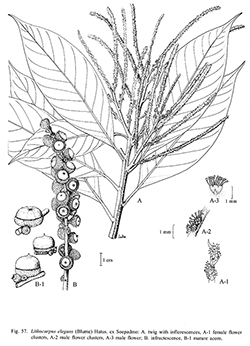e-Flora of Thailand
Volume 9 > Part 3 > Year 2008 > Page 279 > Fagaceae > Lithocarpus
16. Lithocarpus elegans (Blume) Hatus. ex Soepadmowfo-0000229897
Reinwardtia 8: 236. 1970; Fl. Males., ser. I,7: 366. 1972.— Quercus elegans Blume, Verh. Batav. Genootsch. Kunsten 9: 208. 1823; Backer & Bakh.f., Fl. Java 2: 7. 1965.Fig. 57.
Accepted Name : This is currently accepted.
Synonyms & Citations :
Description : Tree, 5–25 m high, 60–150 cm girth. Terminal buds ovoid, 2–5 by 2–3 mm; bracts ovate to linear, tomentose then glabrescent. Twigs greyish pubescent then glabrescent, lenticellate. Bark greyish-brown, scaly, 1–2.5 cm thick; inner bark yellowish-orange to dark red; sapwood white, heartwood dark brown. Stipules ovate to linear, 3–6 by 1–2 mm. Leaves oblong, elliptic oblong, obovate or lanceolate, 10–22 by 3.5–9 cm; base slightly cuneate or oblique, rarely obtuse; apex acute, acuminate or caudate, rarely obtuse; margins entire; coriaceous to subcoriaceous, pubescent then glabrescent, dull green on the upper surface, glaucous-green on the lower, sometimes glossy green above; midrib and nerves prominent on the lower surface, depressed on the upper, usually yellowish-pink when dry; lateral nerves 9–14 pairs, arched but not anastomosing, scalariform veins hardly distinct. Petiole 1.5–3 cm, glabrous, black when dry. Inflorescences male and female separate, rarely mixed, terminal and axillary, tomentose. Male inflorescence a panicle or spike; spikes or spikelets 7–20 cm long; bracts and bracteoles ovate or elliptic, 0.5–1.5–0.2–1 mm, tomentose outside. Male flowers white or yellowish, in 9–10-flowered cluster; calyx 6-lobed, obconical, 0.5–1 mm long, lobes divided by ⅓ to the base, pubescent outside; stamens 12, ca 2 mm long, glabrous; rudimentary ovary subglobose, ca 1 mm in diam., hirsute. Female inflorescence spike or few branched, spikes or spikelets 12–20 cm long. Female flowers always in 3–7-flowered cluster, other characters as in male flowers; styles 3, cylindrical ca 1 mm long; stigmata pointed. Acorns sessile, broadly ovoid, strongly depressed at both ends, 1.5–2 by 2–2.5 cm (including cupule); on erect and slender woody infructescence, 15–30 cm long, acorns fused near base but still distinct, indehiscent. Cupule distinctly saucer shaped, enclosing ⅕–⅓ of the nut; wall comprising alternate tomentose scales, fused (some free) at base, acute apex free and pointed. Nut broadly ovoid, flattened at both ends or slightly convex on top, 1–1.2 by 1.7–2.2 cm, glossy or brown.
Thailand : NORTHERN: Chiang Mai, Chiang Rai, Nan, Lampang, Tak, Sukhothai; NORTH-EASTERN: Phetchabun, Loei, Sakon Nakhon; EASTERN: Chaiyaphum, Nakhon Rachasima, Si Sa Ket, Ubon Rachathani; SOUTH-WESTERN: Kanchanaburi; CENTRAL: Lop Buri; SOUTH-EASTERN: Chanthaburi; PENINSULAR: Ranong, Trang, Satun, Songkhla, Narathiwat.
Distribution : India, Bhutan, Burma, Laos, Vietnam, Cambodia, China, Malaysia, Singapore, Indonesia (type).
Ecology : Tropical evergreen rain forests, dry evergreen rain forests, deciduous dipterocarp forests, lower montane pine-oak forests, on granite, limestone or sandstone bedrock, 20–1,550 m (most commonly 600–900 m). Flowering: March–November (most commonly April–August); fruiting: March–December (most commonly July–December).
Vernacular : Ko hin (ก่อหิน), ko neng (ก่อเหน่ง)(Northern); ko soi (ก่อสร้อย), ko khi mu (ก่อขี้หมู)(Northeastern); ko khi mu (ก่อขี้หมู), mak ko mo (มักก่อหมอ)(Eastern); ko mu (ก่อหมู), ta lap tao pun (ตลับเต้าปูน), ko na ring (ก่อนะริง), ko mu (ก่อหมู)(Peninsular).
Uses: Nuts edible, a pioneer species for forest plantation.

